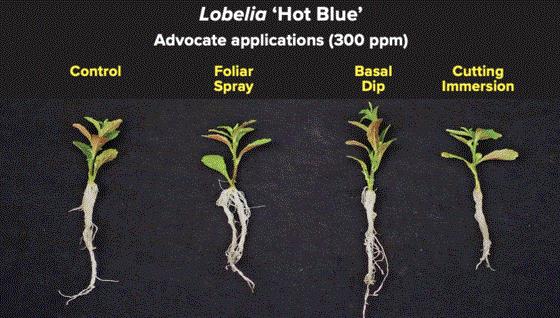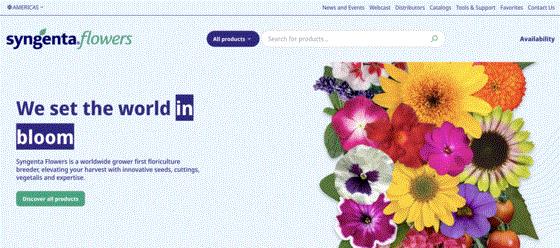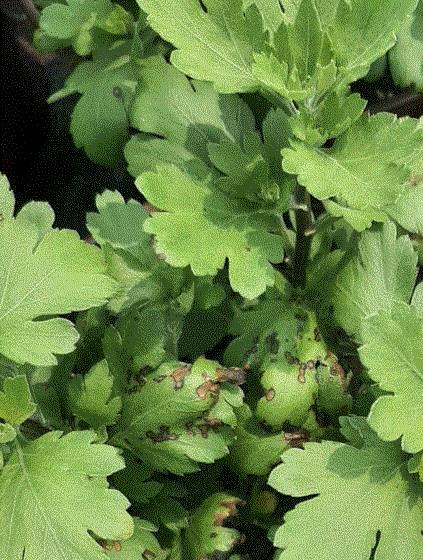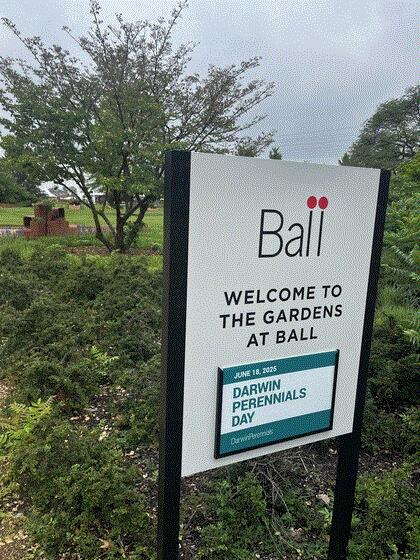NEW PODCAST! Preemergence Weed Control for Greenhouses & Nurseries
The latest Tech On Demand podcast episode (#186) includes critical information for both nursery and greenhouse producers! You may or may not know exactly how much time, labor and money you spend each year managing weeds in outdoor and indoor production, but chances are it’s a lot. If you don’t have protocols and strategies in place for weed control, that can lead to even bigger issues.

Check out PREEMERGENCE WEED CONTROL FOR GREENHOUSES & NURSERIES to hear from two guests from Envu—Dr. Janna Beckerman and Steve Larson—who hopped on the ’cast to talk through best management practices related to weed control, and specifically the use of Marengo, a preemergence herbicide that not only controls more than 90 weeds (including broadleaf weeds, grasses and sedge) but also clocks in with residual activity for up to eight months. It’s labeled for use inside greenhouses and can be a key player in your greenhouse sanitation lineup.
Envu’s Janna and Steve have decades of experience in our industry and bring a lot to the table when it comes to the science behind greenhouse and nursery production, as well as the real-world application of products and strategies. When it comes to weed control in production settings, Janna said it best: The greatest cost is the cost of neglect.
In this episode, the conversation starts with an overview of Envu’s history and innovative product range before quickly moving into weed control in nursery and greenhouse production. From regionality and seasonality of weeds and their impact, to application strategies for preemergence herbicides and keys to safe use, there’s a lot to discuss. And with its residual staying power, wide range of weeds controlled and labeled indoor applications, Marengo (granular and liquid) is a product with benefits for just about every type of greenhouse and nursery operation.
You’ll want to listen all the way to the end of this episode to hear all the tips, tricks, research and anecdotal success stories the Envu team had to share!
Be sure to subscribe to the Tech On Demand podcast on your favorite app so you never miss an episode. And if you’re not a regular listener, jump back into the archives and get caught up—there are more than 185 episodes as of today.

Josh’s Tip of the Week: Rooting Hormones
Usually, I work with my buddy Nick Flax, a technical services expert at Ball Seed, to share a concern that’s come up during one of his numerous calls with growers across North America. This week, I want to include some technical training developed by Josh Henry and shared with Ball Seed sales reps at the national sales meeting earlier this week.
PROBLEM: Without understanding the process of rooting, or the latest best practices for rooting hormone application and moisture management during propagation, you might be working harder than you need to when producing successful liners.

Photo: Michigan State University
JOSH’S TIP: Typically applied as a dip or spray, rooting hormones like indole-3-butyric acid (IBA) and 1-naphthaleneacetic acid (NAA) can be used to improve rooting success and uniformity of vegetative cuttings, especially in slow or difficult-to-root species.
How roots form: After a cutting is stuck, auxins play an important role in stimulating root development. Auxin is a naturally occurring plant hormone that is produced in the meristem (shoot tip) and is transported downward. When auxin accumulates at the base of the cutting, it stimulates root initiation (adventitious roots). This is why rooting hormones, which are synthetically derived from auxins like indole-3-butryic acid (IBA) and 1-naphthaleneacetic acid (NAA), can be applied to improve rooting success and uniformity. Roots move water, which is why it makes sense that roots develop from xylem (water transporting vessels), not the callus.
Types of rooting hormones: Rooting hormones are available as powders or liquids and are typically applied as a dip, soak or spray. While the potassium salt formulations of these rooting hormones are water soluble, other formulations must first be dissolved in solvents like alcohol, which can cause phytotoxicity.
The application methods are specified on each product label and depend on the product formulation. The key to effective use of rooting hormones is to apply the active ingredient in a way that contacts the base of the cutting, where root formation is desired. Dips into powder or liquid rooting hormones have long been used in vegetative propagation and while they are effective, they also are labor-intensive and pose risk of spreading disease. Thus, rooting hormone solutions used for dipping should be changed between crops.
Rates and volume: The typical rates used for propagation depend largely on the product formulation, application method and crops being grown. Foliar applications to annuals generally range from 50 to 400 ppm but may be as high as 800 ppm for herbaceous perennials. Higher rates pose the risk of leaf and stem distortion and chlorosis (yellowing). Application volume is an important consideration. While typical spray volumes (2 qt./100 sq. ft.) can be effective, higher volume sprenches (4-8 qt./100 sq. ft.) can help deposit rooting hormone near the base of the cutting, providing higher efficacy. However, sprenches provide more total active ingredient than sprays per unit of area, so application rates should be lower when application volume is increased.
Timing: When using powder or liquid products as a dip, the application is made at the time of sticking. For foliar applications, sprays should be applied within 24-48 hours of sticking. Making foliar applications the day after sticking gives cuttings time to rehydrate, providing lower stress conditions to spray. Turn off the mist for one to two hours after application to allow the rooting hormone to be absorbed by the cutting. If rooting is slow, a second foliar application can be made one to two weeks after sticking.
While rooting hormone is generally beneficial for any plant species, some species yield greater benefit from their application than others, as can be seen in Table 1 from this e-GRO Alert.
Remember, always read and follow the label to ensure products are compatible with your intended application.
For more information, check out these additional resources:

Syngenta Flowers Website Refresh
Eliminating confusion and streamlining product selection was the goal when Syngenta Flowers retooled and relaunched their global web platform. Now, no matter where you are in the world, Syngenta's website will deliver products and resources appropriate for your location.
According to Fabian Cuevas, global digital marketing lead at Syngenta Flowers, “This website embodies our customer-first philosophy. By listening carefully to our distributors and growers, we've created a digital experience that delivers precisely what they've asked for—reliable information, innovative tools and best-in-class technical support tailored to growers' needs and unique regional requirements."

Syngenta Flowers’ global head of marketing, Emily Mason, explained that one of the company’s greatest assets is technical expertise, and the new website platform makes that information more accessible than ever. I spent some time poking around the site and I’ll agree it’s quite intuitive and packed with multimedia culture information—from crop culture to videos for key varieties and more.
According to the company, The enhanced website features:
-
Regional Customization: Automatic IP recognition directs visitors to the appropriate regional website and can be manually adjusted—for example, when traveling abroad.
-
Accelerated Search Functionality: Find products, technical information, and resources quickly.
-
Complete Product Information: Dynamic, automated product pages have all images, marketing positioning and technical details in one place.
-
Mobile-First Design: Functionality is optimized for mobile access, bringing technical knowledge directly to your fingertips, in the field or greenhouse.
-
Enhanced Technical Support: Comprehensive growing guides and resources are organized by crop, making in-depth cultural information readily accessible.
For more information and to check out the new website, visit SYNGENTAFLOWERS.COM.

Pecto (aka Erwinia) On Poinsettias
If you root your own poinsettias, you may have encountered Pectobacterium in past seasons. It’s the soft rot that smells horrible—like dead fish. If you’ve had it, you know the odor. The Tech On Demand team has some tips for preventing losses due to this nasty pathogen.
Pectobacterium (formerly called Erwinia) is an opportunistic bacterial pathogen that’s pretty much always present. Think of it as the Botrytis of the bacterial world in your greenhouse. It’s everywhere, exclusion is virtually impossible, and the only feasible methods to prevent it from ripping through your propagation area are cultural and chemical management.

Like most bacterial pathogens, environmental factors that favor disease include warm temperatures and ample free moisture. Every poinsettia propagation area needs to be warm and moist, so keep in mind that there’s only so much you can do to mitigate this without stressing your URCs and slowing liner production.
However, one cultural practice for reduce bacterial soft rot that many growers miss the mark on is not overwetting liner media. For growers who use phenolic foam (Oasis) strips this is less of an issue, as excess moisture readily flows out of the wedges. Peat-based media and other organic substrates, on the other hand, can easily be overwetted during propagation, especially early in production. So make sure your mist intervals and duration are dialed in, so only the foliage is wetted and minimal moisture is added to your rooting media.
Another good way to combat excess moisture in propagation media and the resulting soft rot is to apply a wetting agent to URCs after sticking. Capsil is commonly applied to freshly stuck URCs to spread out water droplets that form on the leaves from overhead mist. This makes water droplets evaporate more quickly so water can more readily enter cuttings as vapor through the stomata (this is the only way cuttings can effectively take up water and stay turgid without roots). The result? Less water needs to be applied to cuttings to keep them turgid, media is less likely to become waterlogged, and conditions are less favorable for Pectobacterium to strike.
And as always, thoroughly sanitize your propagation area and use fresh, disease-free media when sticking cuttings.
When sanitation and cultural management fail to control Pecto, chemical controls are the most sure-fire way to curb an outbreak. In most scenarios, applying a broad-spectrum bactericide shortly after stick serves as a good insurance policy, even if you’re exercising cultural BMPs (best management practices). Copper-based products are commonly used and are quite effective when applied correctly, but the tech team is a strong proponent of using biologicals to fight bacterial soft rot. From both experience and reports from of growers we’ve worked with, broad-spectrum biosolutions like Cease provide excellent control of Pecto and offer additional benefits over traditional chemistries.
The REI for Cease and similar products is as low as four hours, so there’s virtually no risk of phytotoxicity, and Cease even has a wetting agent-like effect on accumulated mist droplets after it is applied to crops in propagation.

Prepare for Leaf Spots on Mums
This summer, you might see leaf spots on plants in your garden mum crop. We hope not, but if you do, they can be hard to identify. Misdiagnosing can result in wasted time, wasted money and ultimately damage to crops. Here’s a quick rundown on the two main categories of leaf spot pathogens—fungal and bacterial—and some ideas for prevention and control.
Fungal Leaf Spots
-
Alternaria, Cercospora and Septoria are three common fungal leaf spot pathogens
-
Spots typically appear on older leaves first and will start as chlorotic (yellow) spots that develop into brown/black; whiteish spores on lesions may be visible with a hand lens
-
Free moisture on leaves for extended periods and cool-to-moderate temperatures encourages spore germination and infection
Cultural management. Remove heavily infected plants and clean up dead/fallen leaves. Use drip irrigation to reduce leaf wetness and increase spacing/air flow around crops.

Chemical management. Does not work curatively but can slow/reduce spread if infection occurs. Apply fungicide right before environmental conditions are favorable. Spraying 12 to 24 hours before a rain event will greatly reduce the chances of infection.
Bacterial Leaf Spot (BLS)
Pseudomonas chicorii is the causal agent of BLS in mums
-
Starts as small brown/black spots on both new OR old leaves that grow into irregular shaped lesions (virtually no yellowing compared to fungal spots)
-
High humidity, free moisture and high temperatures encourage infection and spread
-
Physical transmission via personnel or contaminated tools and splashing or wind-blown water are the main spreaders
Cultural management. Exclusion and good sanitation are the first line of defense. Avoid planting infected cuttings/liners and throw out infected plants before they can spread disease to healthy plants (do not compost them!). Sanitize tools, and do not leave watering wands or breakers on the floor. Use drip irrigation to minimize leaf wetness.
Chemical management. Copper-based products are typically the most effective for managing the spread of an existing outbreak. Biological controls are also very effective for managing BLS but must be applied preventatively, as they will do little to curb the spread of an established outbreak.

Finish Line …
I’m writing this newsletter from the “mothership”—Ball Horticultural’s offices in West Chicago—after a fantastic Darwin Perennials Day event. We managed to avoid the rain all morning and welcome hundreds of growers to The Gardens at Ball to visit with more than 30 leading perennials suppliers (Ball Seed perennial supply partners), see thousands of perennial plants in all their glory and hear a dynamic lunch panel discussion about common perennial production mistakes and tips for correcting them.

The panel included three experts with tons of perennial production, product development and research experience: Dr. Nathan Jahnke (Ball culture research manager), Drew Koschmann (director of greenhouses at Walters Gardens) and Chris Fifo (product and technical manager with Darwin and PanAmerican Seed Perennials). They shared valuable information about successful overwintering, input selection, assessing plug quality, managing environmental stress and much more.
If these topics sound interesting or even essential to you, but you missed this year’s event, have no fear! We recorded the whole discussion. I’ll have it edited and released as a podcast ASAP.
It's hard to believe we’re wrapping up June and cruising right into July. For me, it will be a busy month full of work trips and industry events. I’m excited for Cultivate’25 presented by AmericanHort, from July 12 to 15 in Columbus, Ohio. It’s the key national trade show and conference where our industry gathers to network, learn, find new products and connect or reconnect with friends and peers to recap the year and plan for the next. If you’re not registered, now’s the time!
At the very end of July is one of my favorite hort-related events of the entire year: Ball Seed Customer Days in West Chicago, Illinois. Ball has acres of gardens packed with plants, people and inspiration. This year’s Customer Days will be Thursday, July 24 and Friday, July 25 and is open to the trade only. Register at the link above. I look forward to seeing you in The Gardens at Ball!
Until next week … stay cool and keep those mums and poinsettias on track.




Please feel free to send your comments, constructive criticism and topic ideas to me at bcalkins@ballhort.com.

Bill Calkins
Editor - Tech On Demand
This email was received by you and 25,574 other fine subscribers!
If you're interested in advertising in Tech On Demand, contact Kim Brown ASAP and she'll hook you up.